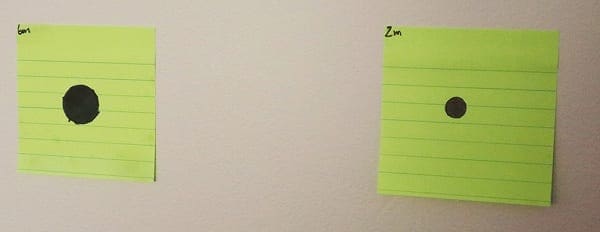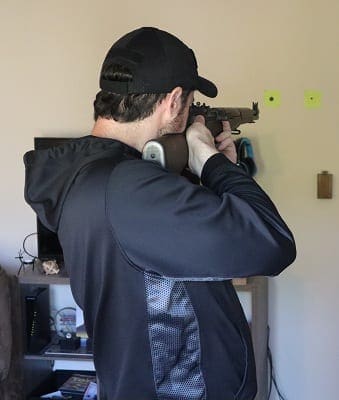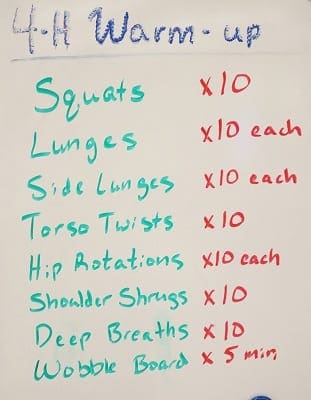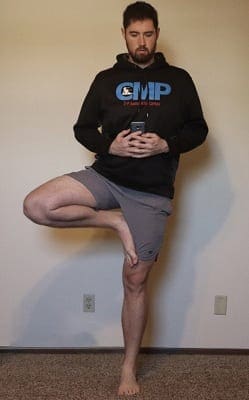Practicing (during) Social Distancing

By Chance Cover, CMP Junior Rifle Camp Director
All the matches are cancelled, the ranges are probably not open, and we’ve been out of school for who-knows-how long. Even the Olympics have been pushed back and are now the 2020NE Tokyo Olympics, according to NBC. But what does this mean for us, stuck at home, with no concrete start to new matches, practices, or events? Well, even though we may not be able to hear the flattening of pellets on backstops, or see neat little round holes appear in our targets, it doesn’t mean we are without training opportunities for the times that we have been given!

Motivation
First things first, let us take a step back and look at why we originally started the sport. What drew us into the sport, what kept us coming back, and what is our reason for training for hours and hours on end and spending (too much) money? It is easy to get lost in the next match, the next score, the next personal best, and lose our original internal – or intrinsic – motivation for competing in the sport. This is what will keep us going for the long term! Our drive, often termed in the academic field as “rage to master,” is our reason for continuing to pursue excellence in a sport long after others have left practice – it’s what keeps us practicing at home when there are no foreseeable opportunities to compete. This motivation is what allows athletes like Kim Rhode to compete in six consecutive Olympic Games, or Michael Phelps to earn eight Gold Medals in a single games.
This is very contextual, remember! The motivation that Kim Rhode or Michael Phelps has to train and compete may not be the same as ours. We have to realize that we aren’t necessarily lacking motivation if we don’t reach that same platform, if it is even one of our goals (we will get to those a little later). This motivation that I am talking about is just what keeps us going and is what will allow us to look at our gear and decide that we want to practice for ourselves without nudges from parents or coaches. External – or extrinsic – factors can be very poor motivators and can lead to burn out or a decrease in our internal motivation.
You may ask “What are internal and external motivators, and how do I recognize them?” A very simple internal motivator that we like to point out in the CMP Summer Camps is the amount of fun you have in a sport. Do you think of the sport as a game or puzzle, or more as work? Are you generally curious about it, do you have a desire to learn, and are you pursuing a sense of achievement that stems from inside? Or are you doing it because somebody else has urged you to, because somebody else will give you recognition for your actions, or will punish you because you haven’t completed a certain action? These are a few of the questions we can ask ourselves when looking at how we have approached the sport. Hopefully you will recognize what motivators you’ve been using and find a few of those internal motivators!

Goals
With our newly rediscovered internal motivations, why not take a look at what we want to achieve next? Goals can be WILDLY different from person to person, and come in three different varieties: process, performance, and outcome goals. I would like to focus more on our process goals and less on performance and outcome goals for this, because who knows when the next match we shoot will be. Performance and outcome goals can come later.
Anyways, let’s decide what we want to work on! A simple formula for working through all of this is to start by picking our long-term goal or goals: what do we ultimately want to accomplish in shooting? Again, this is all contextual. Some people may want to win a medal at the Olympic games. Some people may want to finish high school as the top shooter on their team, and others may just want to enjoy themselves whenever they go to the range. None of these goals are wrong, but they may be wrong for you. Take some time to think about what you want to do. Now we can move on to the hard part by asking “How?” “How will I do that”, “what steps do I have to take”, “where are my weaknesses” and “how do I put myself in the best position to accomplish this goal?” This process continues until you have run out of ways to answer those questions and you have reached the fundamentals. We can call the answers to these questions our “Short Term Goals,” and in order for these to be effective, they have to be SMART (Specific, Measurable, Attainable, Realistic or Relevant, and Time-Oriented). In essence, we must be honest with ourselves, start small, and methodically work our way to the big time goals that we identified.
Now on to the fun part – after identifying our motivations and our goals, what can we do to train during our long stretches at home, away from coaches, teammates, and ranges? Well, luckily I’ve been stuck in my apartment for 7 weeks, so I have a few ideas to share about that.

Training
Training may seem like an impossibility if we don’t have our gear, a range, a target, or whatever else we deem necessary for our practices. But going back to what I said earlier, this is actually an opportunity for us to train in an unconventional method that might provide benefits we don’t have if we only practice at the range. The advantages of practicing at home include the fact that we don’t have as much noise, distraction, or pressure as we might find at the range. This gives us time to look at our positions, think of creative ways to solve problems we may have had for a while, or train our mentality. Let’s start with physical training.
As an example, if you have ever been to the junior rifle camps, you have almost certainly heard your counselor say that a good way to get comfortable in kneeling is to sit in front of the TV on your kneeling roll. Even without any gear, it is beneficial to get into position and be aware of our bodies! Try to get into kneeling and sit there for 30 minutes in the most stable position you can, and I’m sure that you will become aware of any pressure points or tension that builds in your position that you may overlook while staring down the sights. Similarly, in standing or prone, if you get into position and listen carefully to your body, you can learn all about your positions and your body and how they interact. Maybe you have tension in your legs when you stand, or you sway more than you expected. Maybe your back gets tight in prone, or you feel like you are using too much muscle in your arm. A scan of your body in position, from head to toe, can tell you so much more than results on a monitor.
Likewise, we can actually do a lot of good if we just hold while at home. There is some math to be done, but by scaling the target down to a proportional size, we can accurately simulate what the target will look like when we go back to the range. This can be enhanced if you have a Scatt system, but DON’T use it to shoot simulated matches or scores. Getting used to our hold, recognizing what body tension creates which movements, and seeing how long we can focus are all benefits of holding without shooting. Scatt is to be used as a guide in these cases, showing you little things that you missed or holding you accountable to the movements that may be present in your positions.
Training our mentality is just as important, and this is a perfect time to start working on mindfulness, meditation, or any other tool for your mental preparation in shooting. How many thoughts do you think you have in a day? And how many would you classify as negative? Take 5 minutes to just notice and recognize thoughts that enter your mind. Especially now, in times of uncertainty or stress, it is an opportunity to use some tools and practice ways to build your mental fortitude. Recognizing and repeating positive thoughts, remembering your “why”, and learning from failures are just a few ways to do this, and tools like mindfulness are helpful in our journey toward building our mindset. Just like physical training, we can purposefully train our mentality, and this should be incorporated into our goals!

Fitness
One of the most important parts to training while stuck at home is being active. It may be difficult to do all the same things we were doing before, especially due to the gyms closing, but if we aren’t active, we won’t be physically prepared for shooting when the time comes to go back to the range.
The easiest way to start with this is just go for a walk! If able, start with a 10-, 15-, or 30-minute walk. Walking is a great way for us to move, be active, and avoid sitting at home for days on end. Along with the various physical benefits, just walking outside for a period of time can also reduce stress and lighten the mood! Plus, it means Netflix isn’t going to ask us “Are you still watching?” Even if we are okay with yelling at the TV to stop asking us questions, we can still be active and working on other things, like flexibility. Simple stretches like forward folds, butterfly stretches, and arm and leg stretches can have big impacts when we go back to the range.
Next, who can say that their balance is perfect? If you said yes, stand up, stand on one leg, close your eyes, and ask yourself again. Chances are, we could all benefit from some balance exercises. It may seem easy to stand still, but think about how much a small sway at the firing line will affect the path of your projectile downrange. Balance is imperative in our sport at all levels. The nice thing is that improving balance is relatively easy from home. There are so many different exercises to help improve balance, but some of the simplest require only to stand up and move our feet. For example, a simple balance progression would be standing on one leg, then close your eyes, then move your free leg and do toe touches around your body. Another great way to work on your balance is with yoga! Between all the poses and movements, balance is a key component and you will likely see improvements. But if those don’t work for you, there are still plenty of resources for working on your balance from home. YouTube and Google are both filled with free or paid balance workouts and exercises.
In tandem with balance is core strength. Core strength is another very crucial part of shooting, both in how well we do and how long we can shoot. Having a strong core is important in protecting ourselves from injuries, especially lower back injuries, which can be prevalent in the shooting sports. Core exercises, from the most common and simple to the more unorthodox and unknown, will help, but it is important to start where you are comfortable and capable otherwise you risk injury. Exercises like leg lifts, planks, and crunches are a great place to start. More complex exercises may include exercise ball pikes, body-bridges, boat holds – there are a variety of exercises that can be completed, and they can be scaled to a difficulty level that is challenging but safe.
Remember, this is just a small amount of what you can do with your time during quarantine or social distancing. There are entire fields of study dedicated to each of the 4 topics I touched on.
Also, if you’d like to learn a little more, CMP will be doing a virtual camp curriculum this summer and will be diving just a little more deeply into these topics, and more. For athletes and coaches, we will get into areas of learning that will build our fundamentals, explore and push the boundaries of our skills, and hopefully provide some ideas to help us reach our goals. Stay close to (but at a safe distance from!) the CMP for the release date of that course.
The Civilian Marksmanship Program is a federally chartered 501 (c) (3) non-profit corporation. It is dedicated to firearm safety and marksmanship training and to the promotion of marksmanship competition for citizens of the United States. For more information about the CMP and its programs, log onto www.TheCMP.org.

